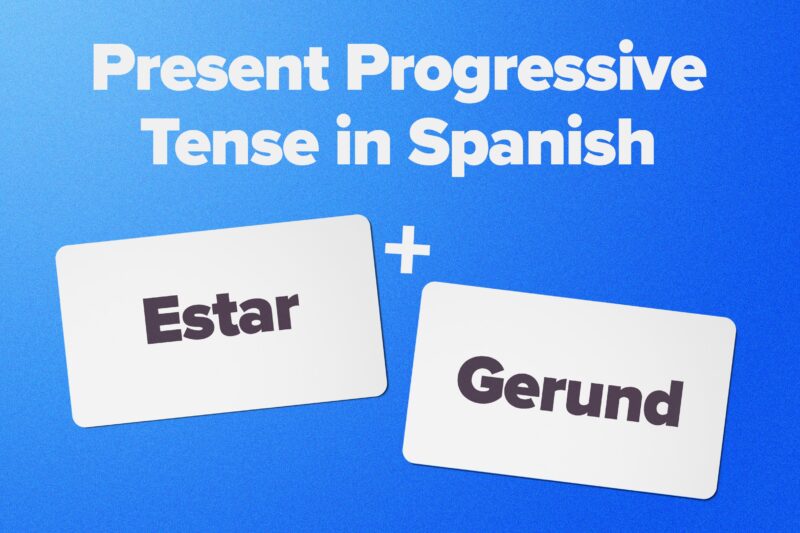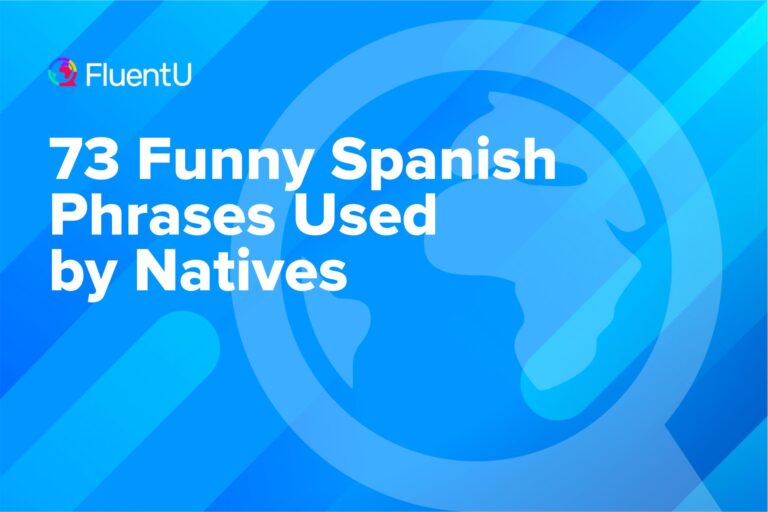Using the Present Progressive in Spanish

We use the Spanish present progressive to talk about what we’re doing right now.You form it by conjugating estar (to be) + the present progressive form of the verb. For example, if you wanted to say, “I’m reading” in Spanish, that would be “Estoy leyendo.”
But the biggest problem for English-speaking Spanish learners with the present progressive is actually the tendency to overuse it. In this post, we’ll go over what the present progressive in Spanish is, how to conjugate it and when and when not to use it.
Download: This blog post is available as a convenient and portable PDF that you can take anywhere. Click here to get a copy. (Download)
Steps to Form the Spanish Present Progressive
The Spanish present progressive is formed by combining a conjugated version of estar (to be) with a present progressive gerund of the main verb.
Let’s go through how this works, step by step.
1. Conjugate estar in the present tense
To form the present tense, you’re first going to need the present tense of estar (to be).
How you conjugate it depends on who is performing the action:
| Pronoun | Estar Conjugation | English |
|---|---|---|
| Yo | Estoy | I am |
| Tú | Estás | You are |
| Él/Ella/Usted | Está | He is/she is/you (formal) are |
| Nosotros | Estamos | We are |
| Vosotros | Estáis | You are (informal plural, Spain only) |
| Ellos/Ellas/Ustedes | Están | They are, you (plural) are |
2. Add the gerund form of the second verb
Next, you’ll need the gerund form of the second verb, which is like the English verbs with the -ing ending tacked on.
Unlike with the auxiliary verb estar, this Spanish verb form is not conjugated according to who is performing an action.
Instead, there are two different present progressive endings for regular verbs.
For verbs ending in -ar:
Take off the -ar ending and add -ando.
For verbs ending in -er or -ir:
Take off the -er or -ir ending and add -iendo.
Examples:
| Verb | Gerund | English |
|---|---|---|
| Bailar | Bailando | Dancing |
| Comer | Comiendo | Eating |
| Escribir | Escribiendo | Writing |
3. Put the conjugated estar and second verb together
Put together the elements from steps one and two, and you have a present progressive phrase!
For example:
Ellos están bailando. — They are dancing.
Estoy comiendo. — I am eating.
Estamos escribiendo. — We are writing.
As with the regular present tense, you don’t necessarily need to use pronouns (yo, tú, etc.) for these sentences if it’s clear who you’re talking about.
Irregulars in the Spanish Present Progressive Tense
As usual with Spanish grammar rules, there are exceptions.
Fortunately, in the case of gerunds, the irregular verbs aren’t very different from the regular verbs.
Verbs with gerunds ending in -yendo
We’ve already seen one irregular verb in the introduction to this post: leyendo (reading), which is from the verb leer (to read).
This -yendo ending is used when an -er or -ir verb’s stem ends in a vowel. Here are some other common examples of this:
| Verb | Gerund | English |
|---|---|---|
| Creer | Creyendo | Believing |
| Atraer | Atrayendo | Attracting |
| Oír | Oyendo | Hearing |
| Huir | Huyendo | Escaping |
| Destruir | Destruyendo | Destroying |
The gerund for the verb ir (to go) is simply yendo.
Stem-changing verbs
The stems of these “stem-changing verbs” undergo different spelling changes in the present progressive—the vowel e becomes i, and the vowel o becomes u.
These forms are very common and worth memorizing. And you’ll notice that these stems undergo the same change in the preterite.
Here are some of the most common examples:
| Stem-changing Verb | Gerund | English |
|---|---|---|
| Dormir | Durmiendo | Sleeping |
| Pedir | Pidiendo | Asking for |
| Decir | Diciendo | Saying |
| Sentir | Sintiendo | Feeling |
| Mentir | Mintiendo | Lying |
| Morir | Muriendo | Dying |
| Venir | Viniendo | Coming |
| Seguir | Siguiendo | Following |
The -er verb poder also follows this pattern and becomes pudiendo (being able to).
Verb stems ending in ñ or ll
If the verb stem ends in ñ or ll, then -er and -ir verbs get the ending -endo.
(The i in the usual -iendo ending has disappeared because its sound is already “contained” in the consonant ñ or ll.)
For example:
| Infinitive | Gerund | English |
|---|---|---|
| Gruñir | Gruñendo | Growling |
| Bullir | Bullendo | Boiling |
| Teñir | Tiñendo | Dyeing |
Using the Spanish Present Progressive
With Pronouns
There are two ways to use pronouns with the present progressive in Spanish.
First, pronouns can go before the verb estar or at the end of the gerund.
For example:
La estoy escribiendo. — I’m writing it.
Lo está cocinando. — She is cooking it.
The second way is to attach the pronoun at the end of the gerund. But doing this, you need to add an accent mark.
For example:
Estoy escribiéndola. — I’m writing it.
Está cocinándolo. — She is cooking it.
Negating the Present Progressive
It’s super easy to negate the present progressive tense. Just put “no” before the conjugated form of “estar.”
For example:
Yo estoy hablando. → No estoy hablando. (I’m not talking.)
Tú estás comiendo. → No estás comiendo. (You’re not eating.)
Using the Present Progressive in a Question
Asking questions with the present progressive tense is very straightforward.
The structure doesn’t change at all if you use intonation to ask the question. Or, you can place the subject pronoun before or after estar.
Let’s look at some examples:
¿Estás comiendo? — Are you eating?
¿Está ella leyendo un libro? — Is she reading a book?
¿Nosotros estamos llegando a la fiesta? — Are we arriving at the party?
When to Use the Present Progressive in Spanish
The Spanish present progressive is used to talk about actions that are going on right now. This means the action is taking place as you’re speaking.
Take a look at these examples:
¡Mira! ¡El bebé está caminando! — Look! The baby is walking!
Moisés está trabajando en el jardín y no puede hablar contigo. — Moses is working in the garden (i.e., right now) and can’t talk to you.
No quiero salir porque está lloviendo. — I don’t want to go out because it’s raining (i.e., the rain is falling now, and I can see it if I look outside).
When Not to Use the Present Progressive
The trickiest thing about learning the Spanish present progressive as an English speaker is that you’ll want to use it too much—even when it’s incorrect.
Here are a few situations where you shouldn’t use the present progressive:
- When the action isn’t happening right now. For example, saying “Estoy estudiando español” would imply that you have a Spanish textbook in hand or are currently flipping through flashcards.
- When you want to say you do something habitually. Going back to the previous example, if you want to tell someone you’re studying Spanish (but not at this very moment), you’d use the simple present tense: “Estudio español.”
- When talking about the immediate future. Another problem for English speakers is using gerunds to talk about the immediate future. But you do not use the present progressive in Spanish to discuss the future. Instead of saying “Mañana estoy bailando con Matilda” (Tomorrow I’m dancing with Matilda), you’d say “Mañana voy a bailar con Matilda” (Tomorrow I’m going to dance with Matilda).
Understanding when to use the Spanish present progressive will get easier the more you read and listen to the language.
For example, you could use a language learning program like FluentU to learn Spanish grammar rules in context with videos.
FluentU takes authentic videos—like music videos, movie trailers, news and inspiring talks—and turns them into personalized language learning lessons.
You can try FluentU for free for 2 weeks. Check out the website or download the iOS app or Android app.
P.S. If you decide to sign up now, you can take advantage of our current sale!

Spanish Present Progressive Tense Quiz
Conjugate the verbs in parentheses into the present progressive tense, then check your answers below.
1. Yo (caminar) a la escuela. (I’m walking to school.)
2. Tú (llamar) a tu amiga. (You’re calling your friend.)
3. Nosotros (llegar) ahora. (We’re arriving right now.)
4. Él (jugar) fútbol con su hijo. (He’s playing soccer with his son.)
5. ¿Ustedes (hacer) la tarea? (Are you doing your homework?)
6. Yo (mirar) la televisión. (I’m watching TV.)
7. Ellas (ir) al cine juntas. (They’re going to the movie theater together.)
8. Yo (pensar) en ti. (I’m thinking of you.)
9. ¿Que (tomar) tú? (What are you drinking?)
10. Yo no (hacer) nada. (I’m not doing anything.)
Answer key:
1. estoy caminando
2. estás llamando
3. estamos llegando
4. está jugando
5. están haciendo
6. estoy mirando
7. están yendo
8. estoy pensando
9. estás tomando
10. estoy haciendo
What are you doing right now? What are those around you doing?
You should now have the verb forms you need to report this in Spanish. This way, you can talk all about the present moment and what’s happening in it.
Download: This blog post is available as a convenient and portable PDF that you can take anywhere. Click here to get a copy. (Download)
And One More Thing…
If you've made it this far that means you probably enjoy learning Spanish with engaging material and will then love FluentU.
Other sites use scripted content. FluentU uses a natural approach that helps you ease into the Spanish language and culture over time. You’ll learn Spanish as it’s actually spoken by real people.
FluentU has a wide variety of videos, as you can see here:

FluentU brings native videos within reach with interactive transcripts. You can tap on any word to look it up instantly. Every definition has examples that have been written to help you understand how the word is used. If you see an interesting word you don’t know, you can add it to a vocab list.

Review a complete interactive transcript under the Dialogue tab, and find words and phrases listed under Vocab.

Learn all the vocabulary in any video with FluentU’s robust learning engine. Swipe left or right to see more examples of the word you’re on.

The best part is that FluentU keeps track of the vocabulary that you’re learning, and gives you extra practice with difficult words. It'll even remind you when it’s time to review what you’ve learned. Every learner has a truly personalized experience, even if they’re learning with the same video.
Start using the FluentU website on your computer or tablet or, better yet, download the FluentU app from the iTunes or Google Play store. Click here to take advantage of our current sale! (Expires at the end of this month.)







